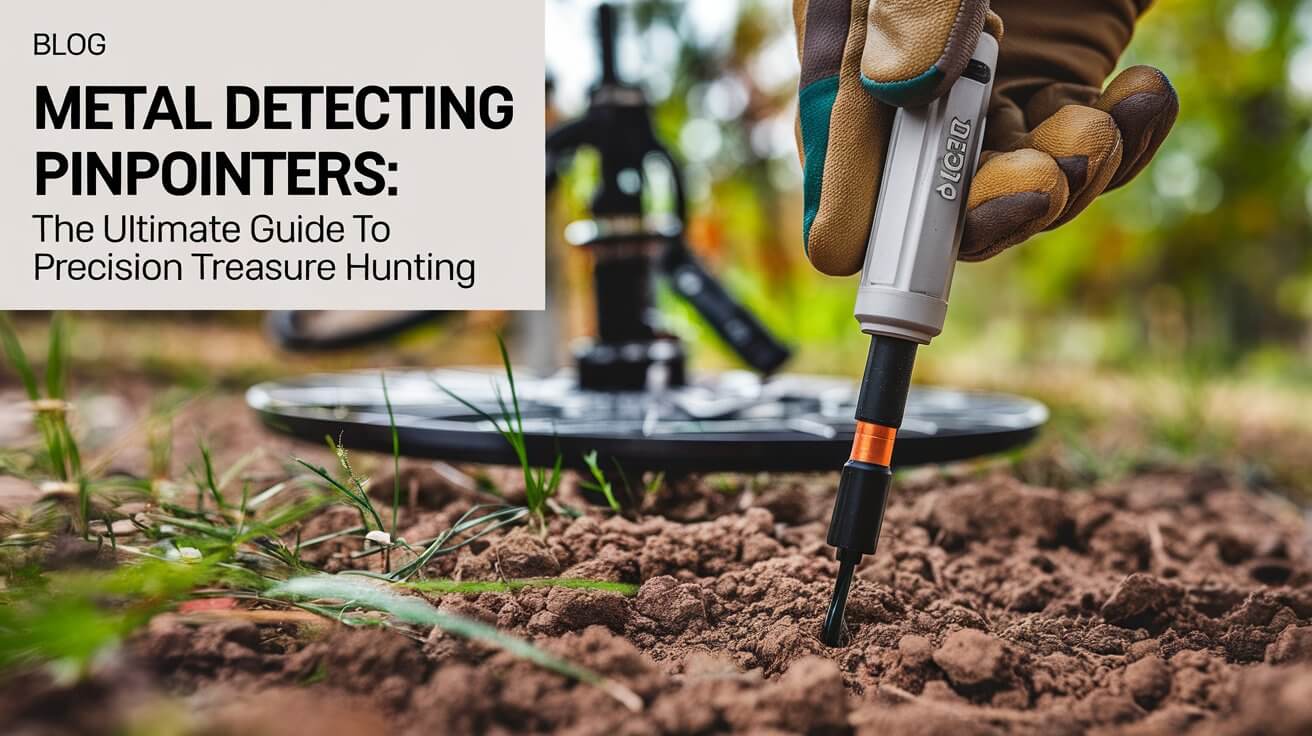
Metal detecting pinpointers are handheld devices that help treasure hunters locate small objects with pinpoint accuracy. These tools complement traditional metal detectors, making the hunt for coins, jewelry, and relics more efficient and rewarding. This guide covers everything from the basics of pinpointers to advanced techniques, helping both beginners and seasoned detectorists elevate their treasure hunting game.
What Are Metal Detecting Pinpointers?
Definition and Purpose
Metal detecting pinpointers are compact, probe-like tools designed to zero in on the exact location of buried metal objects. They work by emitting a magnetic field that interacts with metallic items, producing audible or vibrating alerts when metal is detected.
These devices serve a crucial purpose in the metal detecting process. After your main detector signals the presence of a target, a pinpointer helps you:
- Narrow down the precise spot to dig
- Reduce the size of your excavation
- Quickly find small objects in loose soil or sand
How Pinpointers Complement Traditional Metal Detectors
While full-sized metal detectors excel at scanning large areas, they often lack the precision needed for pinpoint accuracy. This is where pinpointers shine. They bridge the gap between initial detection and recovery, streamlining the treasure hunting process.
Pinpointers offer several advantages:
- Speed up target recovery
- Minimize damage to fragile finds
- Reduce ground disturbance
- Improve success rates in challenging environments
By using a pinpointer alongside your main detector, you’ll spend less time digging and more time discovering treasures.
The Evolution of Pinpointer Technology
Early Pinpointers vs. Modern Devices
The first pinpointers were basic tools with limited functionality. They often suffered from:
- Poor sensitivity
- Limited depth detection
- Lack of waterproofing
- Short battery life
Modern pinpointers have come a long way. Today’s devices boast features like:
- Multiple sensitivity settings
- Waterproof construction
- Extended battery life
- Advanced audio and vibration alerts
Key Technological Advancements
Recent years have seen significant improvements in pinpointer technology:
- Enhanced Sensitivity: Modern pinpointers can detect smaller targets at greater depths.
- Waterproofing: Many models are now fully submersible, perfect for underwater detecting.
- Adjustable Sensitivity: Users can fine-tune their devices for different environments and target types.
- Rechargeable Batteries: Some pinpointers now feature USB-rechargeable batteries, reducing waste and operating costs.
- Lost Pinpointer Alarms: Advanced models emit alerts if left inactive, preventing accidental loss in the field.
These advancements have made pinpointers more versatile and user-friendly, catering to a wide range of detecting scenarios.
Benefits of Using a Metal Detecting Pinpointer
Increased Accuracy in Target Location
Pinpointers excel at precise target location. They can detect metal objects within inches, or even fractions of an inch. This accuracy means:
- Less time spent searching through dirt
- Higher chances of recovering small items
- Reduced risk of damaging valuable finds
Time-Saving Advantages
Using a pinpointer can significantly cut down your recovery time. Instead of digging large holes and sifting through piles of dirt, you can:
- Quickly identify the exact spot to dig
- Minimize the size of your excavation
- Spend more time detecting and less time digging
Reduced Ground Disturbance
Pinpointers help minimize environmental impact. By allowing for smaller, more precise digs, they:
- Preserve the integrity of detecting sites
- Reduce the risk of damaging buried objects
- Make it easier to return the area to its original state
Improved Recovery of Small Objects
Small items like earrings, thin chains, or tiny coins can be challenging to locate with a full-sized detector. Pinpointers shine in these situations by:
- Detecting minute metal objects
- Helping sift through loose soil or sand
- Identifying targets in tight spaces or crevices
Essential Features of Quality Pinpointers
Detection Modes and Sensitivity Settings
Top-notch pinpointers offer multiple detection modes and adjustable sensitivity:
- Static vs. dynamic detection modes
- High, medium, and low sensitivity settings
- Ability to retune or recalibrate in mineralized soil
These features allow detectorists to adapt their pinpointers to various environments and target types.
Audio and Vibration Alerts
Most modern pinpointers use a combination of audio and vibration alerts:
- Increasing frequency or intensity as you get closer to the target
- Optional silent mode for stealthy operation
- Adjustable volume levels
Some advanced models even offer different tones for various metal types.
Waterproof Capabilities
Waterproofing is crucial for versatile detecting:
- Fully submersible models for underwater use
- Water-resistant options for rainy conditions
- Ability to rinse off dirt and sand easily
Look for pinpointers with clear depth ratings to match your detecting needs.
Battery Life and Power Options
Long battery life is essential for extended detecting sessions:
- Typical battery life ranges from 20 to 40 hours
- Some models use standard batteries, while others are rechargeable
- Low battery indicators help prevent unexpected power loss in the field
Durability and Construction Materials
Quality pinpointers are built to withstand tough conditions:
- Rugged plastics or metals for the body
- Scratch-resistant probe tips
- Shock-resistant electronics
Consider models with lanyard attachments or belt holsters for easy carrying and to prevent loss.
Top Metal Detecting Pinpointer Brands and Models
Garrett Pro-Pointer Series
Garrett is a leader in the pinpointer market, offering popular models like:
- Garrett Pro-Pointer AT (All-Terrain)
- Garrett Pro-Pointer II
These devices are known for their reliability and user-friendly features.
Minelab Pro-Find Series
Minelab’s offerings include:
- Minelab Pro-Find 20
- Minelab Pro-Find 35
These pinpointers are praised for their sensitivity and build quality.
Nokta Makro Pinpointers
Nokta Makro has gained popularity with models such as:
- Nokta Makro PulseDive
- Nokta Makro Pointer
They offer a good balance of features and affordability.
XP MI-6 Pinpointer
The XP MI-6 is known for its:
- Wireless compatibility with XP detectors
- High sensitivity
- Robust construction
Budget-Friendly Options
For those new to detecting or on a tight budget, consider:
- Quest XPointer
- Dr. Otek Pinpointer
While they may lack some advanced features, these models offer good value for beginners.
How to Use a Metal Detecting Pinpointer Effectively
Basic Operating Techniques
To get the most out of your pinpointer:
- Turn it on and calibrate according to the manufacturer’s instructions
- Sweep the probe slowly over the target area
- Listen for changes in tone or feel for vibrations
- Narrow down the location by approaching from different angles
- Once pinpointed, dig carefully to retrieve your find
Advanced Tips for Maximizing Accuracy
Improve your pinpointing skills with these techniques:
- Use the tip of the probe for precise detection
- Practice with known targets to understand your device’s behavior
- Adjust sensitivity based on ground conditions and target size
- Combine audio and vibration cues for better accuracy
Integrating Pinpointers with Your Metal Detecting Routine
Make your pinpointer an essential part of your detecting process:
- Use your main detector to identify a target area
- Switch to your pinpointer to locate the exact position
- Dig a small, precise hole
- Use the pinpointer again to check the hole and dirt pile
- Recover your find and fill in the hole
Maintenance and Care for Your Pinpointer
Cleaning and Storage Best Practices
Keep your pinpointer in top condition:
- Rinse with fresh water after use, especially in salt water or muddy conditions
- Dry thoroughly before storage
- Store in a cool, dry place
- Remove batteries for long-term storage
Troubleshooting Common Issues
Address common problems:
- False signals: Recalibrate or adjust sensitivity
- Decreased sensitivity: Check battery level and clean the device
- Water damage: Follow manufacturer’s drying procedures
Extending the Lifespan of Your Device
Protect your investment:
- Use a protective case or holster
- Avoid extreme temperatures
- Replace worn parts (like battery compartment seals) promptly
- Follow manufacturer’s recommendations for firmware updates
Choosing the Right Pinpointer for Your Needs
Factors to Consider When Purchasing
When selecting a pinpointer, think about:
- Your budget
- Desired features (waterproofing, adjustable sensitivity, etc.)
- Compatibility with your main detector
- Warranty and customer support
Matching Pinpointers to Detecting Environments
Different environments may require specific features:
- Beach and saltwater: Fully waterproof, corrosion-resistant models
- Highly mineralized soil: Pinpointers with ground balance or retune functions
- Cold climates: Devices with good battery life and easy-to-use controls with gloves
Beginner vs. Advanced User Considerations
Novice detectorists might prioritize:
- Ease of use
- Affordability
- Durability
Experienced users might look for:
- Advanced features like multi-frequency operation
- Wireless compatibility with high-end detectors
- Customizable settings
Real-World Applications of Metal Detecting Pinpointers
Beach and Underwater Treasure Hunting
Pinpointers excel in sandy and underwater environments:
- Quickly locate small jewelry items in shifting sand
- Find coins and relics in shallow water
- Explore sunken ships or underwater historical sites
Relic Hunting in Historical Sites
When searching for historical artifacts:
- Pinpoint small buttons, buckles, or coins
- Minimize ground disturbance in sensitive areas
- Improve recovery rates of fragile items
Coin Shooting in Parks and Fields
Pinpointers help coin hunters:
- Locate targets in root-filled or rocky soil
- Differentiate between multiple targets in close proximity
- Recover deeply buried coins with precision
Gold Prospecting Applications
For gold hunters, pinpointers can:
- Detect small gold nuggets in crevices or bedrock
- Sift through concentrates more efficiently
- Locate tiny flakes in gold-bearing areas
Legal and Ethical Considerations
Understanding Local Laws and Regulations
Before detecting, always:
- Research local and national laws regarding metal detecting
- Obtain necessary permits for public lands
- Understand regulations about keeping or reporting finds
Respecting Private Property and Protected Areas
Ethical detecting means:
- Always getting permission before detecting on private property
- Avoiding protected historical sites or nature reserves
- Respecting “No Trespassing” signs and boundary markers
Ethical Metal Detecting Practices
Responsible detectorists:
- Fill all holes and leave no trace
- Report significant historical finds to proper authorities
- Dispose of modern trash found while detecting
- Educate others about responsible detecting practices
The Future of Metal Detecting Pinpointers
Emerging Technologies and Innovations
Keep an eye out for these potential advancements:
- Integration with smartphone apps for logging finds
- Improved target identification capabilities
- Enhanced depth detection
- More eco-friendly power sources
Predictions for Next-Generation Devices
Future pinpointers might feature:
- Augmented reality displays for visual target location
- AI-powered sensitivity adjustments
- Ultra-compact, wearable designs
- Integration with GPS for precise find logging
Conclusion: Elevating Your Metal Detecting Experience with Pinpointers
Metal detecting pinpointers have revolutionized the way we hunt for treasure. These compact, powerful tools enhance accuracy, save time, and improve recovery rates across all types of detecting. Whether you’re a weekend warrior or a seasoned pro, incorporating a quality pinpointer into your kit can significantly boost your success and enjoyment in the field.
As technology continues to advance, we can expect even more exciting developments in pinpointer design and functionality. By staying informed about the latest trends and mastering the use of these invaluable tools, you’ll be well-equipped to unearth hidden treasures and make the most of every detecting adventure.
Remember, the key to successful detecting lies not just in having the right tools, but in using them responsibly and ethically. Happy hunting, and may your pinpointer lead you to exciting discoveries!






